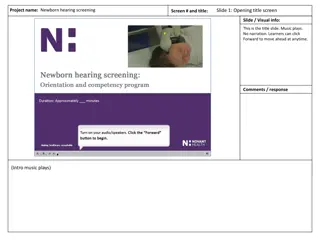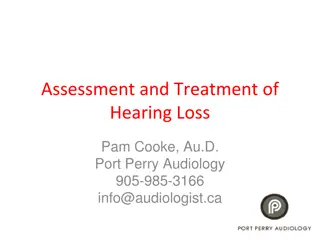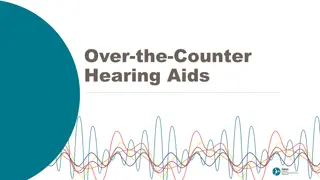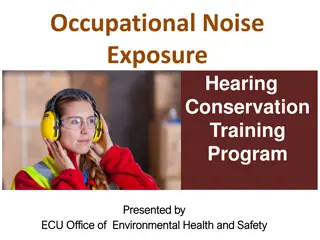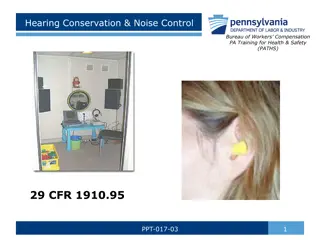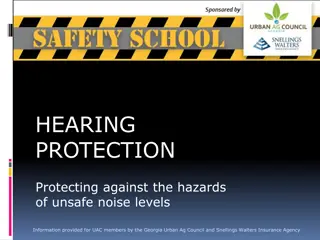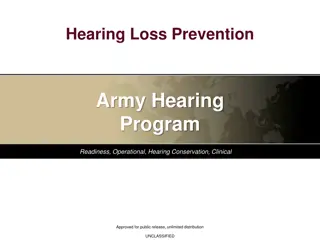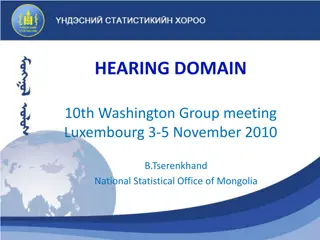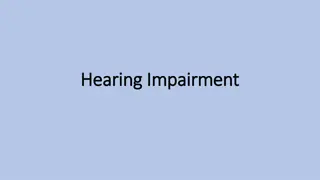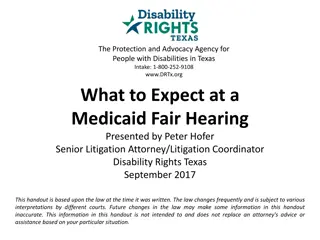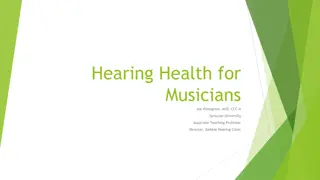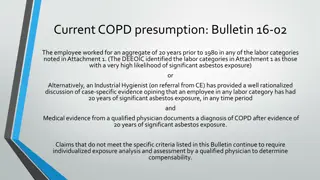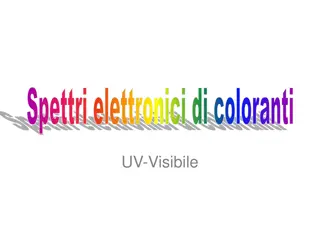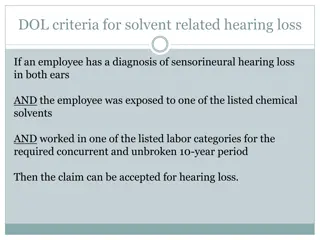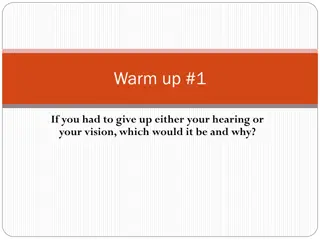Development of Presumption Criteria for Solvent-Induced Hearing Loss
Development of a presumption criteria by the Department of Labor (DOL) for identifying the exposure-disease relationship in cases of solvent-induced hearing loss. The DOL requires a diagnosis of sensorineural hearing loss in both ears, exposure to specific solvents, and a history of working in designated labor categories for a minimum period to accept a compensation claim. Animal studies show how solvents like styrene and toluene damage the cochlea, leading to hearing loss, while human epidemiological research provides further insight into the impact on workers. Alternative criteria may apply for workers who do not meet the presumption requirements.
Download Presentation

Please find below an Image/Link to download the presentation.
The content on the website is provided AS IS for your information and personal use only. It may not be sold, licensed, or shared on other websites without obtaining consent from the author. Download presentation by click this link. If you encounter any issues during the download, it is possible that the publisher has removed the file from their server.
E N D
Presentation Transcript
Development of presumption Identify exposure-disease relationship Identify reasonable dose/exposure needed for presumption requirement can be met using job title, interview Identify criteria for diagnosis Specify how workers who do not meet presumption can meet alternative criteria
DOL criteria for solvent related hearing loss If an employee has a diagnosis of sensorineural hearing loss in both ears AND the employee was exposed to one of the listed chemical solvents AND worked in one of the listed labor categories for the required concurrent and unbroken 10-year period Then the claim can be accepted for hearing loss.
DOL will accept a claim for these solvents as cause of hearing loss Toluene Styrene Xylene Trichlorethylene Methyl Ethyl Ketone Methyl Isobutyl Ketone Ethyl Benzene
DOL accepts the following job categories, when held for a period of at least ten consecutive years prior to 1990, as qualifying for compensation for solvent induced hearing loss Boilermaker Chemical Operator Chemist Electrician/Electrical Maintenance/Lineman Electroplater/Electroplating Technician Garage/Auto/Equipment Mechanic Guard/Security Officer/Security Patrol Officer (i.e. firearm cleaning activities) Instrument Mechanic/Instrument Technician Janitor Laboratory Analyst/Aide Laboratory Technician/Technologist Lubricator Machinist Maintenance Mechanic Millwright Operator (most any kind) Painter Pipefitter Printer/Reproduction Clerk Refrigeration Mechanic/HVAC Mechanic Sheet Metal Worker Utility Operator
Animal data Styrene and toluene, damage the cochlea (predominantly the supporting and outer hair cells (OHCs)) resulting in mid-frequency hearing loss Styrene increased noise damage at levels as low as 300 ppm, and toluene at 1100 ppm. (These were the lowest concentrations studied in animals) Solvents may modify the membranous structures of the OHCs, making them more fragile and vulnerable to noise. Sliwinska-Kowalska M, Prasher D, Alves-Rodrigues C, et al. Ototoxicity of organic solvents: from scientific evidence to health policy. Int J Occup Med Environ Health 2007;20(2):215 22.
Human Epidemiology: Rabinowitz et al Occup Environ Med 2008;65:230 235 1300 hourly workers from five Alcoa locations who were 35 years of age or less at the time of their first recorded test with a minimum of 4 6 years of audiometric follow-up, and at least three audiograms performed during that period. Average air concentrations of solvents were very low (7.6 ppm for xylene, 4.0 ppm for toluene and 21.4 ppm for MEK). In multivariate analysis solvent exposure was significantly associated with high-frequency hearing loss, with OR of 1.87 (95% CI 1.22 to 2.89) Prior studies had estimated adjusted relative risks/odds ratios for hearing loss due to solvent exposure in the range of 1.4 8.25 (see Sliwinska-Kowalska Occup Environ Med April 2008 Vol 65 222-3)
Systematic reviews Recent reviews conclude that both animal and human studies clearly establish effect on solvents on hearing Review of compound specific data has clear limitations since most workers are exposed to multiple solvents Review of mixed exposure data more limited Consensus statements are available from NIOSH (2003), EPA (2003) No consensus on dose-response or existence of threshold in reviews although recent paper has addressed it (through European collaborative study)













